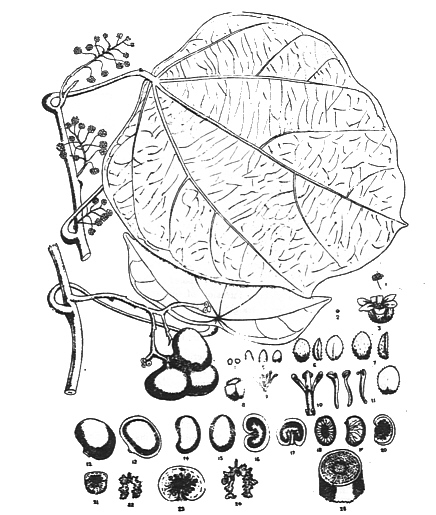

Zitierweise / cite as:
Carakasaṃhitā: Ausgewählte Texte aus der Carakasaṃhitā / übersetzt und erläutert von Alois Payer <1944 - >. -- Anhang A: Pflanzenbeschreibungen. -- Coscinium fenestratum (J. Gaertner) Colebrooke. -- Fassung vom 2007-06-27. -- URL: http://www.payer.de/ayurveda/pflanzen/coscinium_fenestratum.htm
Erstmals publiziert: 2007-06-27
Überarbeitungen:
Anlass: Lehrveranstaltung SS 2007
©opyright: Dieser Text steht der Allgemeinheit zur Verfügung. Eine Verwertung in Publikationen, die über übliche Zitate hinausgeht, bedarf der ausdrücklichen Genehmigung des Verfassers
Dieser Text ist Teil der Abteilung Sanskrit von Tüpfli's Global Village Library
WARNUNG: dies ist der Versuch einer
Übersetzung und Interpretation eines altindischen Textes. Es ist keine
medizinische Anleitung. Vor dem Gebrauch aller hier genannten Heilmittel wird
darum ausdrücklich gewarnt. Nur ein erfahrener, gut ausgebildeter ayurvedischer
Arzt kann Verschreibungen und Behandlungen machen!
Falls Sie die diakritischen Zeichen nicht dargestellt bekommen, installieren Sie eine Schrift mit Diakritika wie z.B. Tahoma.
Verwendete und zitierte Werke siehe: http://www.payer.de/ayurveda/caraka0001.htm

Abb.: Coscinium fenestratum (J. Gaertner) Colebrooke
[Bildquelle: Kirtikar-Basu, ©1918]
Drury:
"Coscinium fenestratum (Colebr.) N. O. Menispermaceae.
- Tree Turmeric, Eng.
- Mara Munjel, Tam.
- Jar-ki-huldie, Duk.
- Mani-pussupoo, Tel.
Description.—Climbing plant with thick ligneous stem and branches; leaves alternate, petioled, cordate, entire, 5-7 nerved, smooth and shining above, very hoary below, acuminate or obtuse, 3-9 inches long, 2-6 broad; petioles downy, shorter than the leaves; flowers in small globular heads, numerous, sub-sessile, villous, of an obscure green; female umbels several
from the same bud, rising from the branches, on thick downy peduncles; the latter longer and thicker in fruit; calyx 6-leaved; 3 exterior sepals oval, downy outside; 3 interior ones longer; petals 6, filaments very downy; style recurved; berries round, villous, size of a large filbert; seed 1; flowers greenish. Fl. Nov.—Dec.—Roxb. Fl. Ind. iii. 809.—Menispermum fenestratum, Gaertn.------Aurungole Pass. Courtallum. Ceylon.
Medical Uses.—This plant, which has long been known in Ceylon, is considered in that country to be a valuable stomachic. The wood is of a deep yellow colour, and bitter to the taste. The root in infusion is used medicinally. This is sliced, and steeped in water for several hours, and then drunk. This is the plant alluded to by Ainslie (Materia Indica, ii. 183), where he says that the root, which is an inch in circumference, is commonly met with in the bazaars, being brought from the mountains for sale. It is employed in preparing certain cooling liniments for the head, as well as in the preparation of a yellow dye. But its chief value consists in its tonic properties, for which the wood and bark are employed.—Lindley. Ainslie.
[Quelle: Drury, Heber <1819 - 1872>: The useful plants of India : with notices of their chief value in commerce, medicine, and the arts. -- 2d ed. with additions and corrections. London : Allen, 1873. -- xvi, 512 p. ; 22 cm. -- s.v.]
Rasa-añjana: Ein Pflanzenextrakt aus der Rinde dāru-haridrā = Coscinium fenestratum (J. Gaertner) Colebrooke (Menispermum fenestratum J. Gaertner), eine Art von Mondsame (Menispermum). Coscinium fenestratum ist eine Kletterpflanze.
| "Method of Preparation: A decoction of the
bark is boiled with an equal quantity of milk until a semi-solid
mass remains. This mass is called rasāñjana. Purification: The rasāñjana is dissolved in boiling water, strained through a cloth and dried by exposing it to the sun." [Quelle: Encyclopaedia of Indian medicine / Ed.: S. K. Ramachandra Rao. - Bombay : Popular Prakashan. -- 25 cm. -- Vol. 4: Materia medica - herbal drugs / ed. S. R. Sudarshan. -- 2005. -- XII, 314 S. : Ill. -- S. 63] |